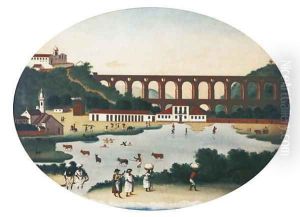Leandro Joaquim Paintings
Leandro Joaquim was a significant Brazilian artist of the 18th century, whose work has left a lasting impact on the Brazilian Baroque and Rococo periods. Born around 1738, in a period characterized by intense artistic and cultural exchanges between Europe and its colonies, Joaquim emerged as a prominent figure in the Brazilian art scene, particularly in Rio de Janeiro, which was a major cultural hub at the time. Despite the scarcity of detailed records about his early life and training, it is believed that he was largely self-taught, drawing inspiration from European artistic trends and adapting them to the local context and materials available in Brazil.
Joaquim's oeuvre is diverse, encompassing religious and secular themes. He is best known for his work as a painter, but his talents also extended to sculpture and architectural decoration, showcasing his versatility as an artist. His paintings often feature vivid colors, elaborate details, and dynamic compositions, characteristics that are emblematic of the Baroque and Rococo styles. However, Joaquim's adaptation of these styles carries a distinctive Brazilian flavor, blending European influences with local themes and elements, such as tropical landscapes and indigenous motifs.
One of Joaquim's most celebrated works is the ceiling painting in the Church of Our Lady of the Conception and Good Death (Igreja de Nossa Senhora da Conceição e Boa Morte) in Rio de Janeiro. This masterpiece exemplifies his skill in creating complex compositions that are both spiritually uplifting and visually captivating. His ability to imbue traditional religious subjects with a sense of immediacy and emotional depth resonated with the devoutly Catholic population of colonial Brazil, while also appealing to secular patrons with his depictions of the natural beauty and diversity of the Brazilian landscape.
Throughout his career, Leandro Joaquim remained an influential figure in Rio de Janeiro's artistic circles, contributing to the development of a uniquely Brazilian artistic identity. His works were not only expressions of religious devotion but also reflections of the social and cultural dynamics of colonial Brazil, capturing the interplay between European colonial powers and the diverse local populations. Despite his death in 1798, Joaquim's legacy endures, with his paintings and sculptures continuing to be admired for their beauty and historical significance. His contribution to Brazilian art is a testament to the rich cultural heritage of Brazil and its capacity to produce artists of extraordinary talent and vision.
